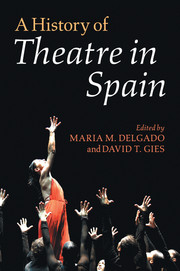Book contents
- Frontmatter
- Contents
- Illustrations
- Contributors
- Acknowledgements
- Introduction
- 1 The challenges of historiography
- 2 Lope de Vega, Calderón de la Barca and Tirso de Molina
- 3 The world as a stage
- 4 Playing the palace
- 5 The art of the actor, 1565–1833
- 6 Theatrical infrastructures, dramatic production and performance, 1700–1759
- 7 Popular theatre and the Spanish stage, 1737–1798
- 8 Theatre of the elites, neoclassicism and the Enlightenment, 1750–1808
- 9 Actors and agency in the modern era, 1801–2010
- 10 Zarzuela
- 11 Nineteenth-century Spanish theatre
- 12 Copyright, buildings, spaces and the nineteenth-century stage
- 13 Modernism and the avant-garde in fin-de-siècle Barcelona and Madrid
- 14 Continuity and innovation in Spanish theatre, 1900–1936
- 15 Theatrical activities during the Spanish Civil War, 1936–1939
- 16 Theatre, colonialism, exile and the Americas
- 17 Theatre under Franco (1939–1975)
- 18 Flamenco
- 19 Nationalism, identity and the theatre across the Spanish state in the democratic era, 1975–2010
- 20 Directors and the Spanish stage, 1823–2010
- 21 This evolution is still ongoing
- 22 Theatre as a process of discovery
- 23 Theatre is the art of the future
- Select bibliography
- Index
- References
14 - Continuity and innovation in Spanish theatre, 1900–1936
Published online by Cambridge University Press: 05 June 2012
- Frontmatter
- Contents
- Illustrations
- Contributors
- Acknowledgements
- Introduction
- 1 The challenges of historiography
- 2 Lope de Vega, Calderón de la Barca and Tirso de Molina
- 3 The world as a stage
- 4 Playing the palace
- 5 The art of the actor, 1565–1833
- 6 Theatrical infrastructures, dramatic production and performance, 1700–1759
- 7 Popular theatre and the Spanish stage, 1737–1798
- 8 Theatre of the elites, neoclassicism and the Enlightenment, 1750–1808
- 9 Actors and agency in the modern era, 1801–2010
- 10 Zarzuela
- 11 Nineteenth-century Spanish theatre
- 12 Copyright, buildings, spaces and the nineteenth-century stage
- 13 Modernism and the avant-garde in fin-de-siècle Barcelona and Madrid
- 14 Continuity and innovation in Spanish theatre, 1900–1936
- 15 Theatrical activities during the Spanish Civil War, 1936–1939
- 16 Theatre, colonialism, exile and the Americas
- 17 Theatre under Franco (1939–1975)
- 18 Flamenco
- 19 Nationalism, identity and the theatre across the Spanish state in the democratic era, 1975–2010
- 20 Directors and the Spanish stage, 1823–2010
- 21 This evolution is still ongoing
- 22 Theatre as a process of discovery
- 23 Theatre is the art of the future
- Select bibliography
- Index
- References
Summary
Continuity was the defining feature of Spanish theatrical practices from 1875 to 1936, with attempts to bring real innovation to the stage hardly bearing fruit until the 1920s and, more particularly, the 1930s. In 1875 the Bourbon Alfonso XII (1857–85) succeeded to the Spanish throne, opening what is commonly known as the Restoration period. In the last quarter of the nineteenth century, Madrid was expanding as a city (mimicked, to a degree, by the provincial capitals), and with urban growth came a larger middle class. The pace of construction of new theatres over this period (documented below) strongly suggests a close correlation of supply and demand. It should surprise no one that demand was, primarily, for the familiar; in the theatre as in other spheres, there was a persuasive argument to be made for ‘business as usual’. On the one hand, mainstream audiences tended to shy away from anything perceived as overly intellectual, artistic or otherwise disconcertingly innovative. On the other, the theatre provided a cultural space in which disturbing changes wrought by modernisation could be rendered tractable, and thus less threatening, by means of humour, ridicule or musical fantasy.
The Restoration period was characterised by its constitutional monarchy (Alfonso XII was followed by Alfonso XIII [1886–1941]; the two major political parties – Conservatives and Liberals – alternated in power), and despite a variety of increasingly grave problems and crises (diplomatic, economic, military, labour-related, etc.), this system of government continued on in Spain until the 1923 coup led by General Primo de Rivera (1870–1930). After a period of dictatorship (1923–30), the Second Republic was declared in 1931, and civil war broke out in the summer of 1936. The country had remained neutral during the First World War, and in the 1920s European avant-garde movements slowly began to make their presence felt in Spain, but only in the most progressive of playwrights and designers and hence on the margins of mainstream theatre. During the 1930s, certain advances were consolidated (for example, the emergence of the theatrical director), and with the advent of the Second Republic the stage mirrored the heightened political climate: a number of propagandistic plays were written and produced, while the government's sociocultural programme led to support for such initiatives as the Misiones Pedagógicas and La Barraca.
- Type
- Chapter
- Information
- A History of Theatre in Spain , pp. 282 - 309Publisher: Cambridge University PressPrint publication year: 2012
References
- 1
- Cited by

